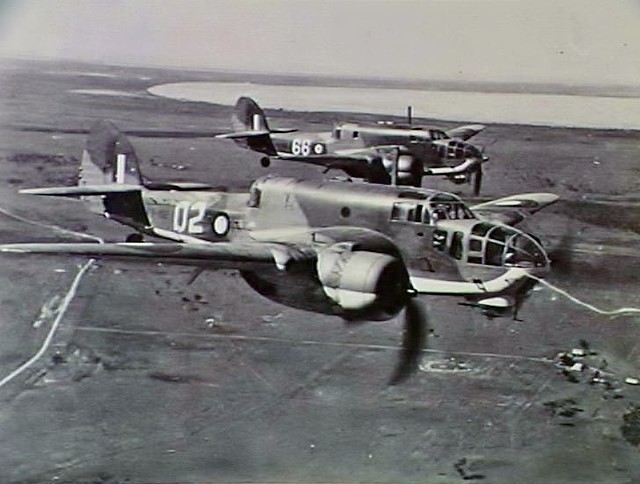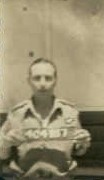Flying Officer Alan Nicol Tanner, the son of Robert Henry Tanner and Ruby Minnianna Tanner was born at Brisbane in Queensland on 6th February 1916. He was educated at the Toowoomba Grammar School. Whilst a student at the school he was a member of the Cadet Unit. After leaving school he worked as a Printer for 6 years and as a Commercial Traveller for 2 years. He was enrolled in the Reserve of the Royal Australian Air Force on 23rd April 1940 after swearing an oath of allegiance. He had previously served in the Citizen Military Force for sixteen months as a Gunner with the 42nd Battery of the Royal Australian Artillery. At the time of his enrolment in the Reserve he was unmarried, employed as a Commercial Traveller with H. Pole & Company, Elizabeth Street Brisbane and resided at 23 Winifred Street, Clayfield, Brisbane.
Flying Officer Alan Tanner, at the age of 24 years and 4 months was enlisted in the Citizen Air Force of the R.A.A.F. at No. 3 Recruiting Centre in Brisbane on 21st June 1940 after giving an undertaking that he would serve for the duration of the war and an additional twelve months. His physical description at the time of enlistment was that he was 5 feet 7 inches in height and weighed 155 pounds. He had a fair complexion brown/green eyes and fair hair. He stated that he was of the Congregational religion. He gave his next of kin as his mother Mrs R.M. Tanner, residing at 23 Winifred Street, Clayfield, Brisbane.
Flying Officer Alan Tanner was allotted the service number of 404187 and he joined No. 2 Initial Training School at Bradfield Park in New South Wales on 24th June 1940 where he was trained in the basics of service life. He joined No. 2 Elementary Flying Training School at Archerfield in Queensland on 22nd August 1940. He attended No. 2 Service Flying Training School at Wagga Wagga in New South Wales on 21st October 1940. He returned to No. 2 Initial Training School at Bradfield Park on 8th December 1940. He joined No. 2 Embarkation Depot at Bradfield Park on 4th January 1941 to prepare for movement overseas on attachment to the Royal Canadian Air Force for further training. He embarked from Sydney in New South Wales on 22nd February 1941. After arriving in Canada he joined No. 2 Air Observer School at Edmonton in Alberta on 17th February 1941. He joined No. 5 Bombing & Gunnery School at Dafoe in Saskatchewan on 9th June 1941
He joined No. 1 Air Navigation School at Rivers in Manitoba on 21st July 1941 and was promoted to the rank of Temporary Sergeant on 22nd July 1941. He joined No. 1 “Y” Depot at Halifax in Nova Scotia on 20th August 1941 to prepare for movement overseas to England on attachment to the Royal Air Force. He embarked from Canada for England on 18th September 1941 and he disembarked in England on 28th September 1941 where he joined No. 3 Personnel Reception Centre at Brighton later that day.
Flying Officer Alan Tanner joined No. 21 Operational Training Unit at Royal Air Force Station Moreton-in-Marsh on 7th October 1941. He joined Royal Air Force Station Harwell 10th February 1942. He was promoted to the rank of Temporary Flight Sergeant on 22nd January 1942. He embarked from the United Kingdom for Transit Centre Almaza in Egypt on 23rd February 1942 and he joined Almaza on 27th February 1942. He joined Headquarters No. 205 Heavy Bomber Group for flying duties 4th March 1942. He joined No. 238 Wing on 7th March 1942 for training. He joined No 108 Squadron Royal Air Force for operational duties on 8th April 1942. He joined No. 23 Personnel Transit Centre on 12th September 1942 to prepare for his return to England and he left Egypt to return to England on 20th September 1942. He was appointed to commissioned rank as a Flying Officer on 22nd October 1942.
Flying Officer Alan Tanner joined No. 1 Air Armament School at Royal Air Force Station Manby on 7th February 1943. He joined Royal Air Force Station Long Marston on 12th March 1943. He joined No. 24 Operational Training Unit at Long Marston on 23rd October 1943. He embarked from the United Kingdom on repatriation to Australia for duty on 25th November 1943 and he disembarked at Brisbane in Queensland on 1st January 1944. He joined No. 1 Operational Training Unit at East Sale in Victoria on 3rd March 1944.
Flying Officer Alan Tanner was the Navigator and crew member of a No. 1 Operational Training Unit Beaufort bomber A9-417 that was lost at sea during a non-operational night flying exercise at 0345 hours on 25th April 1944. The aircraft consisted of a crew of four personnel. During the intensive search conducted only the body of the pilot was retrieved for burial.
The following Accident Report was issued on 31st May 1944:
At 1630 hours on 24th April 1944 the crew of Beaufort A9-417 were briefed to carry out Training Exercise DR-10 (which is a dummy night bombing attack on Hogan Strip of Islands) with the use of radio direction finding. The flight was authorised to commence at 2359K hours on 24th April 1944, for a duration of four and a half hours – the flight commenced according to schedule but the aircraft failed to return to the unit. At about 0120K hours on 25th April 1944, Flying Officer W.A. Carter, an officer on course at this unit observed a dazzling flash of light to seaward between Lakes Entrance and Paynesville. At the same time Aircraftman K.B. Corney, stationed at No. 15 Radar Station, heard an aircraft, coming from the direction of Bairnsdale, pass overhead and go out to sea and then heard a dull boom. Mr R.A. Gray, fisherman, of Lakes Entrance, saw an aircraft out to se between Lakes Entrance and Metung at approximately 0100 hours on 25th April 1944, and very shortly afterwards saw a big orange coloured flash in a position close to where he had seen the aircraft. After the flash died down a pall of black smoke rose and hung over the sea for some time. He also heard a tremendous explosion. The approximate position where the flash was seen was pinpointed. Although there is no direct evidence that the aircraft actually crashed where the flame and pall of black smoke was se4en, there is little doubt, that such is the case.
No evidence is available as to the probable cause of the accident as all necessary examinations of aircraft had been made and the pilot of the aircraft was considered fully competent. Aircraftman K.B. Corney, stated that as the aircraft passed overhead the engines were emitting a normal sound and appeared to be functioning correctly. Searches were carried out from Lakes Entrance and at about 1530 hours on 26th April 1944, the body of Squadron Leader J.K. MacPherson was found floating about three and a half miles from the mainland. For approximately seven days, further searches were made by the members of the Court of Inquiry, which made a low level search for approximately 50 miles from Lake Reeve to Lake Tyers, other Air Force personnel and Mr John Gray, fisherman and launch owner, and the local Constabulary, but no trace was found of the remaining bodies of the crew or the wreckage from the aircraft.
The Court of Enquiry followed up a suggestion that the pilot, Squadron Leader McPherson, may have allowed a crew member to take over control of the flight. The Commanding Officer of No. 1 Operational Training Unit put paid to this suggestion when he wrote:
This is a most exhaustive and thorough investigation, but the cause of the accident remains obscure. It is not understandable that a pilot of Squadron Leader MacPherson’s experience would hand over controls at night to an untrained member of his crew.
Flying Officer Alan Tanner, for his service during World War 2, received the Air Observer Qualification Badge, the 1939/1945 Star, the Africa Star, the Defence Medal, the War Medal and the Australian Service Medal. His name is commemorated locally on the Toowoomba Grammar WW2 Honour Board.
He has no known grave therefore his name is commemorated on the Sydney Memorial to the missing. His name is commemorated on Panel No. 113 at the Australian War Memorial in Canberra and locally on the Toowoomba Grammar School World War 2 Honour Board.
Note: Alan Tanner’s brother, Keith Tanner, also served overseas in World War 2 in the Middle East and New Guinea as a Lieutenant in the 2nd/25th Infantry Battalion.

Australian War Memorial photograph AC0216
Bristol Beauforts of No. 1 Operational Training Unit, Bairnsdale, Victoria.
Toowoomba Grammar School archive records show that he enrolled as a boarder on 3rd February 1930 and he left the School on 16th September 1932. His parent was shown as Mr Robert Henry Tanner of Clayfield. He passed the Junior examination in six subjects.




